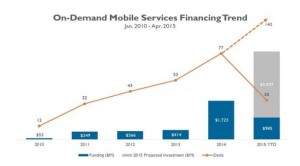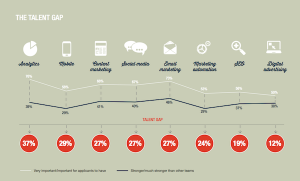
On demand disruption – the knowledge economy
The on demand economy is taking hold, we’ve all heard of Uber and Airbnb success in allowing people to leverage the spare capacity of their cabs and houses’ respectively to meet consumers demands.
Whether their valuations at their last fund raising ($41bn – December 2104 & $28bn – June 2015 respectively) are estimates you agree with or not, the truth of their penetration in their initial market verticals is undeniable. In 2014 Uber had an unofficial $1bn in sales. What the Airbnb graph below doesn’t show is that users have doubled every year since 2012, 35 percent of all signups now come from their incredibly effective referral program.
These have inspired other on demand models focused on our time and skillsets. As recently reported in The Economist in the US earlier this year – In the employment world, companies such as “Handy has 5,000 self-employed home-helps available 24/7 across San Francisco and New York available at moment’s notice; most choose to work between five hours and 35 hours a week, and that the 20% doing most earn $2,500 a month. The company has 200 full-time employees. Founded in 2011, it has raised $40m in venture capital. They can use the apps on their phones to get their apartments cleaned by Handy or Homejoy; their groceries bought and delivered by Instacart; their clothes washed by Washio and their flowers delivered by Bloom. Fancy Hands will provide them with personal assistants who can book trips or negotiate with the cable company. TaskRabbit will send somebody out to pick up a last-minute gift and Shyp will gift-wrap and deliver it. SpoonRocket will deliver a restaurant-quality meal to the door within ten minutes.”
The on demand sector has raised $9.4 billion since 2010, but most of this has come in the past 18 months. Funding for on-demand companies jumped 514 percent last year to $4.12 billion, and new investments in early 2015 have totaled at least $3.78 billion, according to venture capital research firm CB Insights. This is now moving beyond handy men and cleaners and into the knowledge economy.
We believe this boom marks the start of a significant new stage of change and disruption. As the smartphone is becoming the ubiquitous on demand platform, so it will deliver new labour services that challenge organisational design and our preconceptions on career structure across the knowledge economy.
The knowledge economy
The ability of technology to package one companies needs to match an individuals skills is nothing new. Companies like Topcoder were bought by Appirio in 2013, and now offer the services of freelance coders. Elance-oDesk offers 4m companies the services of 10m freelances. In the UK on demand communities such as HackaJob, UXswitch and peopleperhour are small but starting to disrupt the traditional recruitment agency candidate database business model.
However the on demand model is also gaining ground in the professions now, both in the US and the UK. Axiom employs 650 lawyers, services half the Fortune 100 companies, and enjoyed revenues of more than $100m in 2012. Medicast is applying a similar model to doctors in Miami, Los Angeles and San Diego. Freelance lawyers sit in the cloud at InCloudCounsel managing and processing high volume, repetitive legal documents for large enterprises. ICC does this by blending cloud-based software tools with a virtual network of the best boutique law firms (individual lawyers) in North America, undercutting traditional law firms by up to 80%.
In the UK MBA & Company have recently raised a $3.5m funding round, they offer instant access to over 20,000 (and counting) of the best independent consultants globally available for immediate assignments. Using new technology to find the best match for clients project requirements. They have a fast-growing network of clients spanning Enterprise, Consulting and Private Equity, with strong repeat rates underlining the value they bring. Through providing more flexible input they are able to adjust to bring in the strongest skillsets at significantly reduced rates and faster than traditional management consultancy firms.
Tongal with its network of 40,000 video-makers, produced the Super Bowl advert for Colgate-Palmolive, offering $17,000 to anyone who could make a 30-second advertisement for the internet. The ad was so good that the company showed it at the Super Bowl alongside adverts costing several millions of dollars, produced by the global ad agencies. Quillcontent based in the UK, who raised £5m at the beginning of the year as a series A, offer outsourced digital content production, curation and optimisation through their saas platform and network of over 4000 freelance journalists and video producers.
One of the most significant indicators that on-demand services are set to explode within the knowledge economy is Amazon’s Mechanical Turk. Allowing customers to post any “human intelligence task”, giving access to a 24-7 global workforce only paying when you are satisfied with the results. From transcribing audio, editing video captions to reviewing websites.
A perfect storm
The advantages that make on-demand business models attractive are clear for corporates: smaller offices, less full-time contract employees, an ability to access spare time and spare cognitive capacity all across the world, potentially creating a far more flexible workforce. Offering ‘employees’ the ability to work when, where and on what they want.
As with all true disruption there are many hurdles legal and social to overcome. But there are some realities we believe will play into the hands of this continued disruption:
- Trade unions power had receded in the US and UK.
- The digital talent gap – companies can’t hire those with mobile, cloud, data and social media skillset fast enough. This skills gap will continue as technology continues to develop in other areas, thus creating an ongoing need to get the best and brightest involved.
- Millennials will make up 40% of the workforce by 2020. They demand a different approach to work and reward and see technology as an enabler for them to live their lives more on their terms. A fulltime role with the benefits and trappings corporates offer are increasingly unlikely to motivate them.
- Large companies with global workforces increasingly look to reduce costs and recognise the key to future success is developing a more flexible workforce able to adapt and change direction more quickly than traditional organisational design theory or practice has ever allowed.
- The rise of the machine – in a recent McKinsey report it was estimated that the cognitive computing industry will bringing in an estimated $6.7trn (£4.3trn) in productivity by 2025. Fundamental white collar labour change is coming, irrespective of those who would rather maintain the status quo.
- As recently reported by the Economist, according to Ronal Caose insights, “firms make sense when the cost of organising things internally through hierarchies is less than the cost of buying things from the market; they are a way of dealing with the high transaction costs faced when you need to do something moderately complicated. Now that most people carry computers in their pockets which can keep them connected with each other, know where they are, understand their social network and so on, the transaction costs involved in finding people to do things can be pushed a long way down”
A force for good
In Europe and the US on demand labour models can improve the chances of the young unemployed and disconnected parents to gain access to roles in companies they would previously not have had access to. Whilst this is clearly desirable the social impact of reduced employees rights, with no sick pay or overtime will be a fine line to tread.
It seems clear that the on demand ‘craze’ is here to stay and is already spreading into the knowledge economy. Social and legal barriers to change are high, but economic, technology evolution and workforce motivation factors suggest we’re at the beginning of this revolution.





No Comments